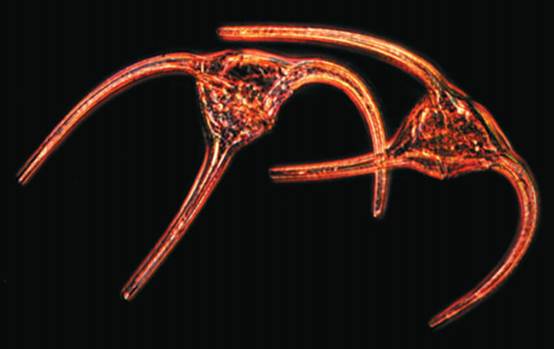


 النبات
النبات
 الحيوان
الحيوان
 الأحياء المجهرية
الأحياء المجهرية
 علم الأمراض
علم الأمراض
 التقانة الإحيائية
التقانة الإحيائية
 التقنية الحيوية المكروبية
التقنية الحيوية المكروبية
 التقنية الحياتية النانوية
التقنية الحياتية النانوية
 علم الأجنة
علم الأجنة
 الأحياء الجزيئي
الأحياء الجزيئي
 علم وظائف الأعضاء
علم وظائف الأعضاء
 الغدد
الغدد
 المضادات الحيوية
المضادات الحيوية|
Read More
Date: 13-10-2015
Date: 22-10-2015
Date: 13-10-2015
|
Locomotion
Locomotion is the active movement from one place to another. It does not include passive movements such as falling or drifting in currents of air or water. Many bacteria and protozoa are capable of locomotion, but animals move over much greater distances by a much larger variety of means, such as burrowing, running, hopping, flying, and swimming. The mode of locomotion used by an animal depends on the size of the animal and the medium in which it moves—whether water, air, or land.
It is convenient to divide the modes of locomotion into four categories: (1) those used by very small organisms in water; (2) those used by larger animals in water; (3) those used by larger animals in air; and (4) those used by animals in or on land.
Swimming
Very small animals, as well as protozoa, that locomote through water are commonly said to swim, but this is not actually what they do. For humans, the momentum of our bodies is very large compared with the resistance from the viscosity (stickiness) of water. For a microscopic crustacean or an amoeba, however, movement through water is like crawling through molasses. There are three types of locomotion commonly employed by tiny aquatic organisms. One is amoeboid motion, which is used by its namesake Amoeba and some other protozoans, as well as by white blood cells. Ameboid motion is performed by protruding a portion of the cell to form a pseudopodium, then essentially flowing into the pseudopodium.
Some protozoans, as well as the sperm of many animals, have one or a few long, hairlike structures called flagella that are responsible for locomotion in liquid. The wavelike beating of a flagellum pulls or pushes the cell through water. Many other protozoans, as well as many small animal larvae, locomote through water by means of numerous cilia. Cilia are identical to flagella except that they are shorter and more numerous. As each cilium beats back and forth, it extends out on the backstroke and folds on the return stroke. Ciliary locomotion can be quite fast: up to 10,000 body lengths per hour for Paramecium.
Cilia are also responsible for locomotion in some much larger organisms, such as flatworms (Platyhelminthes). These animals secrete a film of mucus, and then creep through it on numerous cilia. This is called mucociliary locomotion.
Larger aquatic animals are capable of true swimming, which means that their momentum carries them forward between swimming strokes. The change in momentum that propels them forward is matched by the momentum of water that is propelled backward as a vortex. Most aquatic animals have fins that are adapted for propelling a vortex backward. In addition, fast swimmers generally have streamlined bodies that reduce the friction of water. A few aquatic animals have unusual mechanisms for swimming. Octopus and squid, for example, often escape predators by means of jet propulsion. Contraction of the body forces out a jet of water that propels the animal in the opposite direction.
Flying
Flying is more complicated than swimming since it must generate not only forward thrust but also upward lift. Wings must therefore produce vortices of air that move downward and rearward with a force equal and opposite to the gravitational force on the body. These vortices are produced by the flapping of wings during active flight or by the passive movement of air past the wings during gliding and soaring. Gliding by birds is the easiest to understand. Their wings have a cross section like those of an airplane, and they work similarly. In contrast to the wings of birds and bats, those of insects are flat and rough, and they, therefore, do not generate lift and thrust from the smooth flow of air past them. Instead they have a variety of other movements that produce downward and rearward vortices.

A photomicrograph of protozoans, Ceratium tripos, that uses flagella to locomote through water.
Locomotion by terrestrial animals takes a variety of forms, such as burrowing, creeping, walking, hopping, leaping, and running. In all these modes, the propulsive force is generated as a reaction to forces applied to Earth. When people walk, for instance, they propel themselves forward by pushing the balls of the feet against the stationary Earth.
References
Chong, L., et al. “On the Move.” Science 288 (7 April 2000): 79-106.
Hickman, Cleveland P., Jr., Larry S. Roberts, and Allan Larson. “Animal Movement.” In Integrated Principles of Zoology, 11th ed. Boston: McGraw-Hill Higher Education, 2001.



|
|
|
|
تفوقت في الاختبار على الجميع.. فاكهة "خارقة" في عالم التغذية
|
|
|
|
|
|
|
أمين عام أوبك: النفط الخام والغاز الطبيعي "هبة من الله"
|
|
|
|
|
|
|
قسم شؤون المعارف ينظم دورة عن آليات عمل الفهارس الفنية للموسوعات والكتب لملاكاته
|
|
|